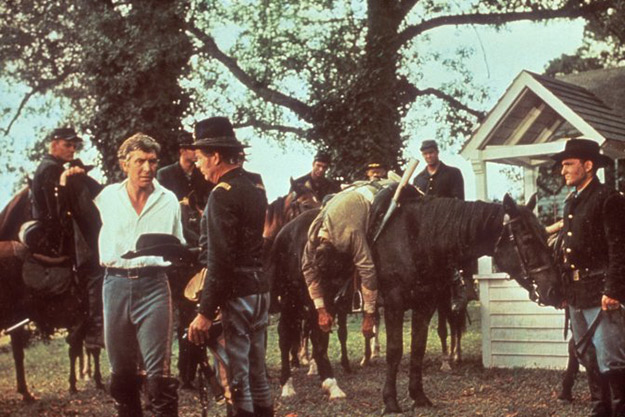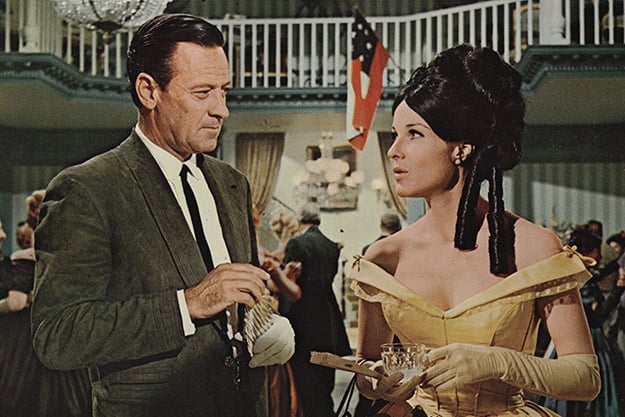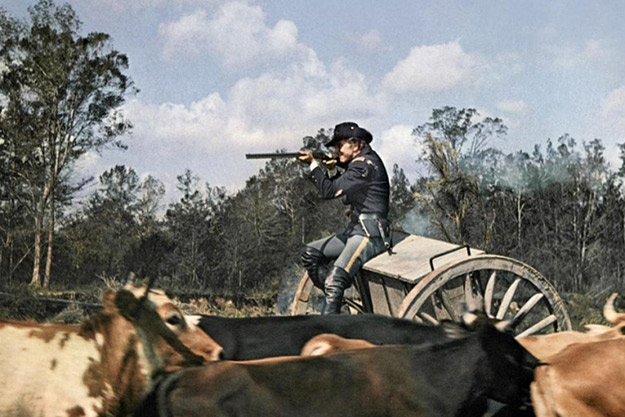TCM Diary: Alvarez Kelly and the Confederates

Alvarez Kelly opens with images of hieroglyphs conveying the ancient nature of human conflict, over which a narrator informs viewers that “in every war, in every age, the forgotten weapon is food… a herd of cattle is as vital as a herd of cannon.” It’s a slightly insecure way of justifying the ensuing film’s potentially mundane story of beef snatching, no small matter when it concerns 2,500 cattle and the survival of legions of hungry Union and Confederate soldiers in the latter days of the American Civil War. The cows belong to the North, but they have to make their way to Union forces stationed in Richmond, so there’s the risk of interception by ravenous Confederate raiders like Colonel Tom Rossiter (Richard Widmark) and his squad. To facilitate the haul, patrician Bostoner Major Steadman (Patrick O’Neal) enlists the eponymous cowboy-adventurer (William Holden), a Mexican national with no partisan sympathies except to what are accurately summarized by Steadman as his “three deities—money, whisky and women.” Rossiter gently but firmly persuades Kelly (by shooting off one of his fingers) to switch sides and help his raiders redirect the beasts to needy Confederate strongholds.
Lincoln called the real Beefsteak Raid that inspired the generously embellished film “the slickest piece of cattle-stealing he ever heard of,” while the narrator coyly notes that Ulysses S. Grant’s cruder reaction was “unquotable.” Besides being a neat piece of grand theft bovine, the affair involved painstaking long-range cattle driving by both sides, and so the film mingles elements of multiple genres including war, heist, melodrama and Western (though the action is confined to the Middle Atlantic states) and is a fine entry in the subgenre of cattle driving films. The laborious struggle of herding thousands of big, ornery animals over dangerous (due to enemies, weather, disease, etc.) and often beautiful, open American terrain (cinematographer Joseph MacDonald captured Alvarez Kelly’s landscapes in Pathécolor in Baton Rouge) makes for readily compelling cinema. If Hawks’s Red River (1948) remains probably the greatest example of the type, other worthy entries include Raoul Walsh’s also Civil War-set The Tall Men (1955), in which veterans of the Confederate Army’s inglorious Quantrill’s Raiders assist with a drive, and Robert Aldrich’s sleazier The Last Sunset (1961), in which Joseph Cotten plays a drunken ex-CSA soldier who served with cowardice during the war. Though Kelly initially lacks loyalties and scruples, he’s not as craven as some of the other hired cattlemen in these films. Once he’s accepted his fate as the Confederacy’s newest resident expert in the cowboy arts, he’s a patient teacher—it turns out the cocky raiders fresh from J.E.B. Stuart’s elite cavalry are bumbling amateurs when it comes to corralling stubborn cows.

Alvarez Kelly’s depiction of Confederate soldiers as essentially a pack of roving criminals (who nonetheless have their own set of moral codes) is far off any romanticized view of, say, a white-bearded Robert E. Lee mounted on Traveller nobly defending a right to Southern soil and a way of life, but it rhymes with similar depictions like Richard Harris’s Union traitor-turned-martyr in Major Dundee (1965) and the Confederate train hijackers in Rio Lobo (1970). The eyepatch Col. Rossiter wears here aligns him with John Wayne’s more famous True Grit character, Rooster Cogburn, himself a veteran of Quantrill’s Raiders who eventually makes good en route to earning a buck for a track and capture job. The Italians, too, found the breakdown of law and order engendered by the American Civil War a fruitful jumping-off point for crime and violence-drenched films, with rogue Confederate soldiers often the villains or antiheroes. The like-themed spaghetti Westerns Django, The Hills Run Red, and The Hellbenders (again with Cotten, Sergio Corbucci’s film’s raping, looting, murdering Lost Causers might make for cinema’s least flattering CSA portrait) were all released in Alvarez Kelly’s year of 1966, and The Good, the Bad and the Ugly, whose Blondie shares a me-first worldview with Kelly, came a year later. In his full redemption by film’s end, Widmark’s Rossiter resembles Harris’s Captain Tyreen and Wayne’s Rooster. Kelly even lets the finger-shooting slide, but only after he arranges passage for Rossiter’s disgruntled fiancée (Janice Rule) behind his back. But, really, for what does Rossiter require redemption? He’s on the wrong side of history, but his short-term goal for lifting the cattle is only to feed his suffering men, making him something of a Dixie Jean Valjean.
Widmark plays Rossiter with a sweaty vigor that hides a dignified gentlemanliness degraded by years of war and hunger. The actor’s alarming Kiss of Death sneer remains, and his comfort in the saddle is evidence of his years in Westerns like The Alamo (1960), Two Rode Together (1961) and 1959’s Warlock, which was also directed by Edward Dmytryk. For Holden, it was a welcome return to the screen after a two-year absence, during which he lost his remaining younger brother to a plane crash (the other had died in World War Two) and consoled himself with his usual double-edged balm, booze. Dmytryk was hesitant to work with the actor again (he had a small role in Dmytryk’s 1939 Million Dollar Legs), and he was no more optimistic when Holden was too drunk on the first morning of shooting to work, until an understanding Widmark resuscitated his friend with black coffee. Despite this, Holden’s salmonella that postponed shooting for six weeks, and Widmark’s flu, Dmytryk and crew were able to shoot around his oft-hungover and forgetful star and make a rousing picture, albeit one with much plot foreplay involving various minor characters that precedes the climactic action.

If making a cattle drive movie requires the adventurous spirit of some of the abovementioned directors, Dmytryk proved he had it—the same toughness he brought to the excellent noir Murder, My Sweet and the anti-racist Crossfire in the 1940s. Holden, well removed by decades of hard living from his baby-faced Golden Boy breakout, has real gravity here, presaging his weathered Pike Bishop in The Wild Bunch (1969) but with a romantic, even sexy charisma in his scenes with Rule and Victoria Shaw as a two-faced plantation widow. It’s comeback kid Holden who makes Kelly’s growth, from the “I don’t care who wins” cad advising that “cattle are like women” to the hard-charging leader who risks a fusillade of Northern Minié balls to save a Confederate soldier’s life, so believable, and moving.
Alvarez Kelly airs April 24 at 9:00 a.m. on Turner Classic Movies.
Justin Stewart is a writer whose work has appeared in Brooklyn Magazine, Reverse Shot and elsewhere.







